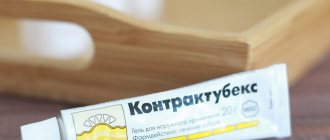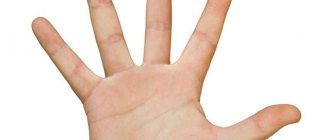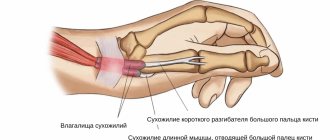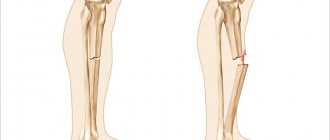Description of Dupuytren's contracture?
When a diagnosis of Dupuytren's Contracture occurs, we are talking about a serious pathology, accompanied by cicatricial degeneration of the tendons involved in the process of flexing the fingers. Over time, this disease can lead to limitation or complete impairment of flexion function.
The discoverer of this pathological condition and the developer of effective treatment methods was the French scientist Guillaume Dupuytren.
Despite the fact that this destructive process is not dangerous for a person, it can provoke a complete loss of ability to engage in work. If the disease is detected at the initial stages, its further spread can be prevented through conservative methods. When diagnosing Dupuytren's contracture in an advanced stage, the only way to restore flexion activity is surgery.
Preparation for inspection
Of course, you can show your hand to your local therapist or surgeon at the clinic. He will refer you to a hand surgery specialist.
Before the inspection, formulate answers to the following questions:
- Do your relatives have similar problems?
- What treatment have you already tried? How did this help?
- What medications do you use regularly?
The doctor will also ask you:
- How long ago did you notice the first symptoms?
- Does it get worse over time?
- Is there pain in your hand?
How much does contracture interfere with everyday life?
Stages of development of Dupuytren's contracture
Taking into account existing statistical data, it can be stated that Dupuytren's contracture of the hand is observed in 3% of people in the world. Moreover, the most susceptible to the disease are males in the age category - from 40 to 60 years. In women, this pathological process is quite rare, in only 4-5% of cases.
Taking into account how pronounced palmar Dupuytren's contracture is, the following stages of development of the disease are distinguished.
First stage
It is characterized by the presence of a small subcutaneous nodule located under the ring finger. In this case, the patient does not feel any discomfort and continues to perform the usual hand movements. The fingers also do not lose their activity at this stage. As a rule, such nodules resemble ordinary calluses of a working person.
Second stage
Progressive stage. During this process, a scar cord appears on the palm. In this case, redness and roughening of the skin in this area are observed. Mobility in the damaged finger deteriorates and, most often, its ability to fully extend is impaired. However, pain syndrome is not detected in this case.
Third stage
The area of spread of the fibrous cord covers the entire finger. In this case, the skin located near the seal takes on a folded and wrinkled appearance. The affected finger is located at an angle of 90° relative to the palm. In addition, in this situation, a sudden deterioration in functional characteristics is monitored.
Patients note the absence of any pain in this part of the body. However, it is quite difficult to move this limb. At this stage, fusion of the joint surfaces may be observed.
Fourth stage
The affected area covers the entire palm or several fingers at once. As a rule, they coalesce into one large scar. The first injured finger assumes a bent position without the possibility of changing it, and significant deformation of the hand occurs. In some situations, patients note the appearance of severe aching pain, which is constant. The ability of the hand to perform any movements in this case is reduced to zero.
Make an appointment Online booking
- Clinic on Krasnopresnenskaya +7 (499) 252-41-35 Volkov lane, 21
- Clinic on Varshavskaya +7 (499) 610-02-09 Varshavskoe highway, 75, building 1
- Clinic in Annino +7 (495) 388-08-08 Varshavskoe highway, 154, building 1
Needle technique
The fibrous cord can be crossed with an injection needle through punctures in the skin and the finger can be straightened. The contracture usually returns, then the procedure can be repeated.
The main advantage of needle (or needle) aponeurotomy is that there is no incision, and the operation can be performed on both arms at the same time.
Postoperative management is simple and the person quickly returns to normal activities. The main disadvantage is an earlier relapse and the possibility of damage to the nerve or tendon (which is extremely rare in reality).
Needle aponeurotomy can also be used for the staged treatment of severe Dupuytren's contracture. At the first stage, the fibrous cord is unbent with the help of punctures; as a rule, it is not possible to bring it into a straight position, but it is possible to transfer the 4th stage to the second. A person immediately becomes more comfortable using his hand. And after 5-6 months it is already possible to carry out a full-fledged open aponeurotomy and “adjust the finger.” This method allows you to speed up rehabilitation after surgery and reduce the risk of complications, because during the time between stages the skin has time to stretch, and the joints “remember” their normal range of motion.
Symptoms of Dupuytren's contracture
The above pathological process is characterized by signs that differ significantly from other diseases. These include the appearance of nodules and cords located under the skin. In this case, the process of finger extension is disrupted.
Dupuytren's contracture mildly manifests itself in the form of a small thickening on the surface of the palm in the area of \u200b\u200bthe spherical joints of the 4-5 fingers. As the disease develops, the size of the formation gradually increases. Subsequently, cords are formed that extend to the main and middle phalanges of the damaged finger.
As the tendon shortens, contracture occurs first in the metacarpophalangeal joint, and later in the proximal joint.
The density of the skin near the formation gradually increases, which is accompanied by its adhesion to nearby tissues, as well as the appearance of retractions and bulges. The cords and knot are clearly visible during finger extension.
Most often, when Dupuytren's contracture of a finger develops, a person does not experience any pain. Only 10% of patients report discomfort in the shoulder or forearm area. It should be noted that this disease is characterized by a progressive course.
Brief history
This disease was first described by Felix Platter in 1614. He mistakenly believed that the cause of deformity and contracture of the fingers was dislocation of the flexor tendons. Only in 1822, the English surgeon Cooper suggested that the palmar aponeurosis was affected. A little later in 1832, the French surgeon Guyom Dupuytren most fully described the clinical picture of this disease. Experimentally proved the dominant role in the development and progression of contracture of the fingers - the palmar aponeurosis. He proposed a method of surgical treatment - aponeurotomy, and wrote a monograph La Main de Dieu adorns, dedicated to the problem of treating contracture. It was from this time that a typical deformity of the fingers was called Dupuytren's contracture.
Which doctor treats Dupuytren's contracture?
To identify palmar fibromatosis and carry out timely treatment measures, you need to contact a traumatologist or orthopedic doctor. In some medical institutions, these specializations are combined into one, and an orthopedic traumatologist deals with the elimination of pathology. To make a clear diagnosis, it is enough for the doctor to perform a visual examination of the patient and listen to his complaints.
During the appointment, the specialist visually assesses the condition of the palm, determines the presence and parameters of cords, and also studies the motor activity of the joints.
If Dupuytren's contracture is suspected, treatment can begin only after a “desktop test” has been performed and positive results have been obtained. During it, the patient places the hand on the table, palm surface down. If the palm and fingers are in contact with the specified plane, the result is negative. If there is even a small gap between the hand and the surface of the table, they make a conclusion about Dupuytren’s contracture and begin to look for ways to treat this pathological process.
Make an appointment Online booking
- Clinic on Krasnopresnenskaya +7 (499) 252-41-35 Volkov lane, 21
- Clinic on Varshavskaya +7 (499) 610-02-09 Varshavskoe highway, 75, building 1
- Clinic in Annino +7 (495) 388-08-08 Varshavskoe highway, 154, building 1
Complications
Dupuytren's contracture impairs hand function. Since the thumb and index fingers are rarely used, many people cope with everyday tasks for quite a long time - with three fingers it is quite possible to write and pick up small objects. As it progresses, it becomes impossible to fully open the palm and grasp large objects (grasp) or fit the hand into narrow spaces (pockets). In later stages, dirt can accumulate in permanent folds of the skin and cause ulcers that will not heal.
Treatment of Dupuytren's contracture
The main goal of treating the destructive process described above is to reduce or completely eliminate scar degeneration in the palm area. At the same time, the choice of the most effective methods may be influenced by the degree of the identified disease and the severity of negative manifestations. Since such a pathology is characterized by deep tissue damage, its elimination should be carried out comprehensively, including the use of physiotherapeutic procedures and medications. If Dupuytren's contracture of the hand is diagnosed in an advanced stage, the patient may require surgery.
If Dupuytren's contracture is detected in the initial stages, treatment without surgery is allowed. Unfortunately, if the second, third and fourth stages of the disease occur, it will not be possible to eliminate it without surgical intervention.
To eliminate Dupuytren's contracture without surgery in Moscow, it is recommended to consult a specialist at the first manifestations of the disease, namely, when a small lump appears on the surface of the palm.
Treatment of Dupuytren's contracture with shock wave therapy
Among the well-known and highly effective methods of getting rid of pathology, the UVT procedure occupies a special place. It is prescribed for various disorders of the musculoskeletal system. During the treatment of Dupuytren's contracture with shock wave therapy, it is possible to achieve the maximum effect - to fragment the foci of connective tissue proliferation, as well as change its mechanical characteristics and destroy microstructural connections.
In addition, treatment of Dupuytren's contracture with shock wave therapy is not associated with any pain for the patient. However, the desired result can be obtained only when the patient exhibits primary signs of the disease. Moreover, a positive effect can be noticed after 1-2 sessions.
In our clinic, the SWT procedure is implemented using innovative Swiss equipment and under the guidance of specialists of the highest level, which eliminates any relapses, provides quick relief to the patient’s condition and allows normalization of motor activity in the fingers with an absolute guarantee.
Medicines for Dupuytren's contracture
If a patient is diagnosed with Dupuytren's contracture and treated without surgery, one cannot count on complete relief from the disease. By using medications, you can only slow down the rate of development of the pathological process. Their use is advisable in the first stages of the spread of the disease, as well as after surgery during the recovery period.
But the doctor can select effective medications to alleviate the symptoms of the pathology if the patient refuses surgical care.
Most often, such therapeutic measures are performed twice a year in the clinic. It is recommended to use the following medications:
- Glucocorticoids (Dexamethasone, Flosteron, Diprospan, etc.). In this case, treatment of Dupuytren's contracture is carried out using injections simultaneously with an anesthetic to relieve inflammation and pain;
- Collagenase. These are injections with Xiaflex, which are performed in the area of contracture in order to destroy collagen fibers in the connective tissue;
- Applications with proteolytic enzymes (Lidase, Trypsin, Ronidase, etc.). They are applied to the affected area to improve metabolism, slow down the process of tissue degeneration, and also soften dense connective tissue formations.
Physiotherapeutic methods for treating Dupuytren's contracture without surgery
Physiotherapeutic procedures are prescribed simultaneously with medications as part of a course of therapy. Unfortunately, it is impossible to completely get rid of the pathological process using such methods, and they are used exclusively at the first manifestations of the disease or during the rehabilitation period after surgery.
For Dupuytren's contracture, similar recommendations related to the use of physiotherapeutic methods can be provided to solve the following problems:
- In order to improve metabolic processes in damaged tissue;
- To soften connective tissue cords;
- In order to restore motor activity of the hand joints.
The following methods can be used to soften existing scar formations:
- Exposure to therapeutic mud;
- Thermal therapy method using heated paraffin and ozokerite.
In order to eliminate the tension of formed seals, the following can be recommended:
- Method using low voltage direct current;
- Exposure to radiation in the red and infrared range (Infrared laser therapy);
- Exposure to high voltage alternating current.
To reduce the rate of formation of new scar formations and resorption of existing strands, use:
- Compresses with the above proteolytic enzymes or electrophoresis.
To activate the muscles of the hand, use:
- Treatment method involving interference currents;
- Electromyostimulation.
In order to dilate blood vessels and increase blood flow in the damaged area, they resort to help:
- Ultraviolet exposure;
- Warm compresses.
Massage plays a special role in the treatment of Dupuytren's contracture, as it helps improve tissue elasticity and helps normalize blood circulation in the area of the palmar aponeurosis.
Hand surgery for Dupuytren's contracture
According to the majority of orthopedic doctors, if the flexion function of the finger deteriorates by more than 30°, surgical intervention is considered the only effective way to solve the problem. In this case, the surgeon must remove all existing scar formations and make every effort to restore normal motor activity of the cyst.
An important condition for achieving the desired result is an individual attitude towards each patient. In this case, the nuances of the course of the disease are taken into account: the area of the hand affected, the rate of development of the pathological process, age group, existing chronic diseases and other factors.
Currently, two types of surgical interventions are practiced: open and closed. The first type of manipulation involves the use of a special tool that is inserted into the palm to separate the tendons. In the second case, the hand is dissected and all fibromatous tissue is removed.
If we compare the above methods, then the closed type procedure is considered the most traumatic. However, after it the disease may re-develop. Considering this point, surgeons often focus on open surgery, during which it is possible to completely remove damaged tissue.
If a patient has a large number of adhesions, doctors resort to dermoplasty with the possibility of transplanting a healthy flap of skin.
It should be noted that after pathological tissue, the wound is drained, after which the skin is sutured and a tight sterile bandage is applied. It prevents the appearance of new scar formations and the formation of blood clots. Next, a fixation splint is applied to the fingers and hand.
After excision of Dupuytren's contracture, the patient is recommended to perform gymnastic exercises to help restore normal motor activity of the fingers.
Make an appointment Online booking
- Clinic on Krasnopresnenskaya +7 (499) 252-41-35 Volkov lane, 21
- Clinic on Varshavskaya +7 (499) 610-02-09 Varshavskoe highway, 75, building 1
- Clinic in Annino +7 (495) 388-08-08 Varshavskoe highway, 154, building 1
Treatment of Dupuytren's contracture at home
Simultaneously with the use of medications, treatment of Dupuytren's contracture without surgery involves the use of traditional medicine. In this case, baths, warm compresses and special sets of exercises demonstrate the greatest effectiveness.
For example, a pine bath allows you to relieve pain in the pathological area. To prepare it, use 500 grams of pine needles, which are filled with water (1 liter) and boiled for half an hour. The infusion period for the decoction is 24 hours. Use slightly warmed.
The folk method, based on the use of applications made from fresh sawdust, horse manure and clay, also gives good results. It is recommended to apply a similar mixture to the affected area 2 times a day. This method helps alleviate the symptoms of the disease.
Many patients resort to using a traditional herbal infusion using chamomile, calendula and eucalyptus. After a short boiling and infusion, sea salt (1 tbsp) is added to the broth and used as intended - for the purpose of steaming a hand damaged by the disease.
A special positive effect for Dupuytren's contracture of the right or left hand can be obtained by using chestnut infusion. To prepare it, fresh raw materials are crushed, placed in a container and ammonia is added there. Infuse the solution for 9-10 days. Use as a rubbing solution for at least 60 days.
Taking into account patient reviews about the use of traditional methods, we can conclude that they are insufficiently effective. That is why you should trust the treatment of Dupuytren’s contracture to an experienced specialist who can give the necessary clinical recommendations and provide an individual approach to each specific situation.
Preventive actions
Until now, experts have not been able to find the true causes of palmar fibromatosis. As a result, until now there are no specific measures to prevent the disease.
However, in order to minimize the likelihood of pathology, for those patients who have a genetic predisposition to Dupuytren's contracture, doctors advise against abusing alcoholic beverages and tobacco products. In addition, it is recommended to practice a healthy diet and abandon a specialty associated with excessive stress on the hands.
List of sources
- Treatment of patients with Dupuytren's contracture (clinical recommendations) - “Nizhny Novgorod Research Institute of Traumatology and Orthopedics”, A.V. Novikov, S.V. Petrov. Nizhny Novgorod, 2013
- Asfura I.I. Complex treatment of Dupuytren's disease. Author's abstract. Ph.D. Minsk. 1986. - 16 p.
- Volkova A.M., Kuznetsova H.JI. Dupuytren's contracture (classification, clinic, diagnosis, treatment, clinical examination). Methodological recommendations for practicing doctors. Sverdlovsk 1986. - 16 p.
- Gerasimenko S.I. Dupuytren's disease and its complex treatment. Author's abstract. dis. Ph.D. Kyiv. 1982. - 20 p.
- Mikusev I.E. Dupuytren's contracture (issues of etiology, pathogenesis and surgical treatment). Kazan. 2001. - 175 p.
Forecast
When this pathology is detected, it is difficult to predict the nature of its further course, since it depends on the individual characteristics of each patient’s body. Thus, in one situation, a slight decrease in motor functionality can be observed for decades, in another, the rapid development of the disease is monitored.
In any case, the disease will certainly enter its final stage. In this case, the only effective way is to perform surgical intervention.
Healing process after surgery
After returning to work and completing a course of physical and occupational therapy, the patient must continue to independently perform the learned exercises for several weeks and even months to avoid the occurrence of scar contractures.
If he has been prescribed a traction splint, he should continue to wear it and only after a few weeks, if no changes are noticed in the scar area, it can be worn less frequently and then not worn at all. Negative sensations in the postoperative scar largely disappear after the first 6-8 weeks; after 3-6 months, patients no longer complain of pain in the scar. However, only after 12 months can we say that the scar has completely healed. © Dr. Klaus Lovka
to the top of the page









